The SLR Camera: Then and Now
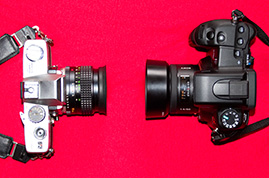
I'm constantly amazed by the things we create. Advances in technology continue to accelerate at an astonishing rate — digital cameras are no exception. Digital photography has taken off in recent years, nearly wiping out the existence of film cameras. Although there are new film cameras being introduced to the market, most of what remains in the hands of photographers are remnants from the past.
Most film photographers I've encountered prefer to use outdated equipment; analog cameras from decades past. Why is this? And is the equipment really outdated? Do these cameras have any substantial benefits over the latest pieces of technology? Let's find out.
35 YEARS APART
As a comparison between old and new, we'll be looking at the following pieces of photography equipment.
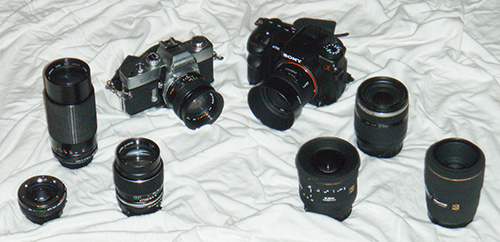
The camera on the left is a 1973-ish Minolta SR-T Super 35mm film SLR. It's fully manual in every aspect — which means focus, shutter speed, and f-number must be set by hand. The camera can operate without any batteries, but it does have a very small (and extremely long-lasting) one to run the light meter (I'd consider that a luxury item on this camera). And after 35 years, it still works just fine. This camera was given to me by my Father (… or maybe he's just lending it to me) several weeks ago. He also had a few lenses for it: 50mm f/1.4, 135mm f/2.8, 80-200mm f/3.9, and a 2x doubler.
The camera on the right is a 2008 Sony Alpha a700 APS-C format dSLR with 12 megapixels. It's fully automatic in every aspect — which means focus, shutter speed, f-number, ISO, etc can be determined by the camera or by the photographer. The camera is useless without a battery, and the battery might only last a few days. I purchased this camera just a few months ago. I also have a small collection of lenses for this camera (most of which were acquired while I was using my Minolta Maxxum 7D): 50mm f/1.4, 100mm f/2.8, 10-20mm f/4-5.6, and 18-200mm f/3.5-6.3.
Both cameras operate in the same basic fashion (since they're both SLRs), but they are also completely different on many levels. And in several areas, I'm finding the old film camera to be superior. Of course there are many more things that the dSLR does better than the film SLR I've shown here, but that's not the point of this article.
So let's explore the reasons I'm falling in love with this old film camera.
NOT A SLAVE TO ELECTRICITY
How amazing is the fact that this old camera can take photos with no assistance from a battery? Every motion it goes through while capturing that image is driven by the potential energy stored when you wind the roll to the next position. Not only that, but the timing for the shutter, mirror flip, and stopping down of the aperture all work in-sync to allow a controlled slice of light to land on the film. It really is amazing.
I did mention this camera has a battery… but I also said it was a luxury item. It runs the light meter (which we'll talk about in a moment), but it isn't critical to the operation of the camera. An external light meter or educated estimate could also suffice.
SLOWING DOWN AND USING YOUR HEAD
I suppose one of the biggest differences between the two cameras is the amount of time they take to use. The dSLR is quick — point, focus, shoot. No messing with manual controls if you don't want to. The film SLR, on the other hand, is painfully slow to frame up a photo. Manual exposure isn't so bad, but the manual focus aspect takes more time and effort for somebody who isn't used to it (like myself).
Not only are the controls slower, but the size of the media is smaller too. 36 shots to a roll rather than several hundred. Granted, you can put more film in the camera, but that costs money. These limits really force you to slow down and pay attention to what you're doing, and that's a good thing.
A SUPERB VIEWFINDER
Having never used a full frame camera before, I hadn't realized how drastically different the viewfinders are. After using the film camera for a short period, looking back through the viewfinder of the dSLR is a bit disappointing.
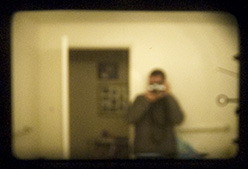
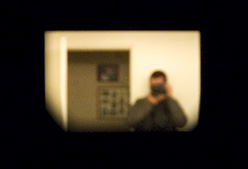
If you've ever had a hard time understanding the “crop factor” on your dSLR, try this little experiment. Get a 35mm camera and a dSLR outfitted with lenses of the same focal length (I have a 50mm for each). Then look at some object through both viewfinders. Guess what? The object is the same size. Your digital camera doesn't magnify things, it just cuts out a bunch of the scene around the edges. Hence the term “crop factor“.
The above images were taken through the viewfinder of my film SLR (left) and my dSLR (right). You can see that the subjects are the same size, but the dSLR shows much less of the scene due to the 1.5x crop factor. The images were not scaled separately, only aligned and cropped simultaneously to produce images fit for the web.
ANALOG LIGHT METERS RULE
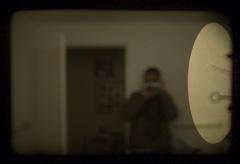
Like I mentioned above, the only reason my film SLR has a battery is to run a light meter. The neat thing about this light meter is that it's analog, meaning it does its job constantly. It's an elegant design — simple, intuitive, and it has such a low power consumption that the battery will last for years.
Digital cameras, on the other hand, only meter the light when you depress the shutter release half-way (unless there are models out there that also provide constant metering). So even if you're using manual mode, you still have to meter the scene with the press of a button. Maybe it's not a big deal for most photographers, but you'd think the camera would at least offer the option for continuous metering.
As shown in this photo, the light meter is the needle and the exposure setting is the ring. As more light enters the lens, the needle moves down. With less light, it moves up. The ring is moved by adjusting your film speed, f-number, and shutter speed. To set the exposure correctly, just make the needle go through the ring.
MANUAL FOCUS, NO PROBLEM
Well… sort of. Focusing a lens manually is still a difficult skill to acquire, no matter how many visual aids you have. See, digital cameras are very much intended to be auto-focused. The focusing rings don't have the latitude you need to fine tune your setting, plus there's no rangefinder to tell you that you're focused properly.
In my film SLR (which has no auto-focus capability), there is a focusing aid built into the camera called a “rangefinder”. The area at the center of the viewfinder gives an indication that the scene is either out of focus or in focus. This particular rangefinder is a “split image rangefinder with a microprism collar and matte ground glass with Fresnel” (seriously…), and it works as shown in the images above. The image to the left is focused too shallow, the center image is focused, and the image on the right is focused too deep. So when your split image goes away, you're in focus. Awfully handy, but it still takes time and effort to achieve sharp focus — especially when using lenses like the 50mm f/1.4!

In these images you can see the actual size of the rangefinder in comparison to the entire frame. The previous images appeared to make the rangefinder quite large, but that's only because of the lens I used to take the photos (105mm macro). So it's basically a chunk of glass that sits directly above the mirror. Again… elegant and simple.
DOES ANY OF THIS STUFF MATTER?
Sure it does! It's interesting to see how things have progressed over the years, and how technology has effected photography. The era of film cameras was a very important one, and it would be wise not to forget where our roots lie.
Also, it would be wise for camera manufacturers to look back at these old cameras every once in a while and take some notes. The people who designed them did a lot of things right, and it appears as though the digital wave has wiped out many of those things.
At the top of the article I pondered why many film photographers prefer to use older equipment. I suppose the answer will be different for everybody, but for me it has something to do with the fact that I'm using a camera that's older than I am and it's the same camera that has taken so many photos of me as a child (plus all the reasons I've listed throughout the article).
Tell me… will your digital camera still be working in 35 years? How about 5 for that matter?



Ryan G
April 4, 2008Great write-up Brian!
I’ve been itchin to get into film recently… this just makes me want to more.
Brian Auer
April 4, 2008Thanks Ryan. I say go for it man — pick up an old antique off eBay or something.
MikeD
April 4, 2008Very cool, brings back memories for me.
The Minolta SR-T was my first camera. My dad gave it to me in ’89 when I took a photography in high school. I recently bought my first DSLR, a 40D (had a Canon Elan IIe between) and am constantly amazed at the technology differences.
the_wolf_brigade
April 4, 2008Awesome! So good to see you integrating yourself back into the film world 😀
After reading this post there is no way that I’m ever going to buy a crop factored Digital. I consider it occasionally, but film provides me with such a rich experience already…
I’m not sure whether it would have been an option on your Minolta, but on some SLR’s you had the option of different focusing screens. I’m personally not a big fan of the split image ones, but occasionally they come in handy like in the case of the shallow 50’s, and especially in macro work.
On most of mine I have a plain fresnel screen where the whole image is the focus adjustment. On my Pentax 6×7 (medium format) this is amazing as it also has a grid to line up verticals and horizontals, and the viewfinder is massive. To see the whole image come in to focus just blows me away every time. Of course there are issues in low light where a split image might be more beneficial.
On the question of what a film SLR can bring versus a digital – I think film SLR’s come with memories. We haven’t reached the point where a digital is going to useful to pass on to our son/daughter in 15 years time. To give a bit of perspective, most of the cameras I’m using are my Dad’s, with the Rolleiflex being his first ever camera, and a Pentax MX being the camera he used to take photos of me when I was a baby almost 30 years ago.
Want more perspective? I’ve just put in to use my great grandfather’s camera. An Exakta Varex IIa. Exakta was the first company to develop a single lense reflex (as far as I know) in the 1920’s, and they were the first to bring out a 35mm SLR. The camera I have of his he bought new in about 1956 in Australia for just over 400 pounds. The cost was worth it as while the lens had fungus due to improper storage, the shutter curtains are fine. It has 27 variable speeds of which the speeds below 1/25 second recently jammed. After over 50 years they’ve only just started to deteriorate! Thanks to a flickr contact (TheWishy) I now have a waist level finder and a lens to put it back in use. Time to make my Grandpa Alex proud. Try doing that with a digital!
Kevin White
April 4, 2008My dad has a Nikon F-something from… I think maybe 1982? That’s not right. Maybe late 70’s? It’s a replacement for one he bought – I think – through that Army catalog thing while he was in Vietnam. Still works great, although the light meter is failing for some inexplicable reason.
Totally manual. I’ve used it a few times. It’s real interesting… I can manually focus it with no problem, but manually focusing my Pentax K100D is practically impossible thanks to the dim viewfinder and lack of the rangefinder prism. It’s also alarmingly heavy… with equivalent 200mm lenses, his camera would probably break a toe if dropped, but mine’s not nearly as clunky.
All that said, it’s really interesting how things have changed while ‘staying the same’ between film and digital.
I’ve tried to get him into digital, but unless it will use his existing lenses with a light meter, he won’t budge. Unfortunately, that means about 1,000 dollars for a Nikon body that can meter with a manual lens. At least Pentax got that one right; the dang thing will meter without a lens even screwed on, I think.
Brian Auer
April 4, 2008I’m starting to see why you’re so into film photography! It really is a more rich experience, but I still wouldn’t give up my digital. There are still plenty of situations where my dSLR will eat my film camera’s lunch — especially with street photography and other situations that require quick responses.
And after seeing the difference between dSLR and 35mm, I can only imagine the difference between 35mm and medium format! That camera of yours is absolutely massive — and now I understand why.
I’m totally on par with you about the sentimental value of the old film cameras, especially those that have been passed down in the family. Like I said, I’m now using the very camera that was used to photograph me as a baby and a child. My parent’s house is still decorated with photos of me as a child from this camera.
Jen Weaver
April 5, 2008It’s so funny you decided to write about this. I recently “dusted off” my Minolta X700 that is about 16 years and it’s good as new. I have really fond memories of the camera that was purchased by my parents for me when I was in high school taking my first photography class. I did a photoshoot of my minolta in my home made lightbox while I was reminiscing…
Then tonight I found my first ever camera purchased for me as a child – A 110!! Yes, I just loved that 100. Part of my wished I found some film from 4th grade still in the camera but no such luck. I decided to take a few photos of the 110 in the lightbox along with my Polaroid and my first ever digital camera in 1998 (A Fuji).
When I sat down to read my RSS feeds and saw your blog post I was happy to see someone else looking back on film cameras besides me. 🙂
Susheel Chandradhas
April 5, 2008Brian,
Great write-up…
Having grown up using cameras like the Zeiss Ikon Contaflex, the Nikon F1, the Hasselblad (medium format wonder) and a varitety of Canons, Minoltas and things in-between, all this seems very normal. I really did not realise how much of a difference it makes to a person who started photography in the digital world! (especially the full-frame and focus bits, because I’ve never used an APS-C frame DSLR)
Susheel Chandradhas
April 5, 2008I really could not resist… Here’s an old shot of my old gear (hover over the picture fore details. Unfortunately we cant use some of them professionally any more…
Luis Cruz
April 5, 2008The last time I shot with film was ages ago, but I can clearly remember how much easier it was to focus manually back then. I really miss what I used to call half-moon screens… now I know they’re, as you stated: “split image rangefinder with a microprism collar and matte ground glass with Fresnel.” I think I’ll stick to calling them half-moons though.
Just wondering, do you think DSLRs will ever have focusing aids like that?
Antoine Khater
April 5, 2008I never shot film yes NEVER ! I started with photography it was already dSLR age kicking.
Actually I can’t imagine how will cameras look like in 35 years. but in 5 years ??? Maybe we will be struggling with 50 MP bodies and killing our computers for finding enough place to store the images.
I recently found out that just 8 years ago (that’s January 2000) a 128 MB CF card cost was $400 !!!!!
Talk about an investment
Antoine Khater
April 5, 2008I will just add that i took the “habit” of shooting with my camera as if it was film based.
That means that
1. I do not use “auto preview” but I DO look at the pictures when in doubt
2. I DON’T shoot a lot at all. I have RARELY gone to an outing and came back with more than “2 rolls” of digital pictures (i.e. 70 pictures) of course that doesn’t apply to events like wedding or parties or or or…
Cheers
Susheel Chandradhas
April 5, 2008@Luis Cruz: We used to call them a “Split Image Finder”! I dont think dSLRs will ever have focusing aids, because most of the time people use AF! It’s very rare that anyone uses manual focus, and these aids were intended only for manual. Even film SLRs with autofocus dropped the split image and microprism parts (they’re difficult to produce).
Damien Franco
April 5, 2008This is a really great write up you have posted. I’ve always said that photographers that started out in film them switched to digital have an advantage of knowledge and habit. I find it hard to imagine that the Dslr’s we are using today will be used in 35 years. Technological advancements will make our expensive cameras look like mere toys in 5-10 years.
IonBuck
April 5, 2008Hey, this is really an eye-opening article! And the old SLR sounds great! Wish I could try one. 😉
his4ever
April 5, 2008Oh that is what I am missing. I learned how to take pictures with a rangefinder. Then I stoped taking pictures for a while and then started to use a Digital SLR. I knew something missing and was wondering why in manual focus mode I could not get things right 😀
Davor
April 5, 2008I was playing around with dad’s Zenith E today. I should really get a roll (of film) or two, and try it out.
Dad
April 5, 2008Son, What a great article, after reading all the cool things about my old camara I think I am going to need it back. I am going to convert your old room into a dark room and go back to processing my own film like the good old days. We can make a trade the camara for the kids. It’s nice to see you getting some good use out of that old camara. What you don’t know is that camara came from your uncle Dave. I am not sure how long he had it before I bought it from him. Next time you take to him ask. The battery has been in the camara for at least 10 years and when i tested it before you got came last week it had a full charge. Dad
Brian Auer
April 5, 2008hhaha, nice try — it’s mine now! Really? It came from Uncle Dave? I’m curious if he bought it new or used… it came from Asia since it’s the “Super” instead of the “102” model. I’ll have to bring it with me when I go to Japan to visit him this fall — he’ll probably trip out on it!
DKL
April 5, 2008Will my camera be working in 5 years? It’s been 8 and my Canon D30 is working real nice. I see no reason to upgrade. I have some L glass which makes the 3.25 megapixels enough for 20×30 prints. Yes, you read that right. Had a photo printed at 20×30 and the guy at the frame shop didn’t believe it was from a digital camera.
Dad
April 6, 2008The camara might have come from Grand Dad as they lived in taiwan in the early 70″s like I did Grand Dad traveled around Asia and might have bought it it Japan or Hong Kong. Dave likely knows where it came from and what year. So, nothing about the trade? well you keep the camara and I get to keep the kids.
Trudy Kasper
April 8, 2008Have been a 35 mm shooter(rangefinder) since early 1950s, and Kodak 120 film cameras for 12 years before that. Got my first Minolta 7000 in 1985 and gave been brand loyal since as I learned a little more about photography. My first digital was a Kodak 1.3 model in the late 90’s, followed by a 3 meg in 2000, which had the amazing ability to shoot frames for a software package that did panoramas. I have a 4 week trip to China, 3 week cruise on Volga, Hawaiian hellicopter shots, all taken with that and later with Konica Minolta and Sony DSLRs. My film history has become fragmented, partly because of losses whil moving some 22 times in the first 12 years of my marriage and partly for lack of working equipment, but I have saved negatives and slides of travels, through at least 20 states and some 18 foreign countries. All my Minolta and Kodak cameras still work, as do all my SLR lenses and accessories, many, many of them. Age and failing eyesight and agility prevent my repeating the subject matter, but I am still loving and occasionally using all my equipment. The flexible arsenal of lenses, adaptors, filters, and such which are interchangeable between the Minolta, Konica and Sony equipment make possible some shots that age and dexterity might otherwise preclude in lesser equipment. Over sixty years of memories. It reminds me of the full life I have had, with much to share with children and grandchildren. Did a bit of black and white processing for about 10 years and then tried color, but had to give that up becasue the lab I used was closed. Hope to join a local group that takes an old slow poke in stride.
Derek
April 9, 2008Brian – I’m with you on this, I’ve only really shot digital my whole “life” but film interests me.
I’ve been getting old cameras from co-workers recently – a early 80’s eara Fujica 35mm SLR – same deal as your Minolta, 100% manual, the battery only powers the meter. Another recently found a Mayima Super 23 Press in his basement. It has a 6×9 back on it and I finally picked up a roll of 120 film to shoot with.
My only hang up is what got most people into digital in the first place – processing is expensive!
Joseph Szymanski
April 10, 2008I started out with a Minolta X-700 older than I am, I still shoot it once in awhile. If you like the bright finders and the split screen focus on an SLR, you’d absolutely fall in love with rangefinders.
I always knew you’d come over to the dark side and get into film one of these days…
Nathan
April 12, 2008Have you discover the mercury battery problem yet.
the_wolf_brigade
April 13, 2008While it depends on the camera, for most applications adapters are available for the battery compartments, so that the silver oxide equivalents can be used. While the voltage often doesn’t match exactly, it’s normally pretty close.
Mike Salmon
April 13, 2008I have a Canon AV-1 with loads of accessories, lenses, 2x converter, close up set, filters, autowinder, original manual, flash. I a the original owner, it was purchased in 1979. Anyone interested in buying? It is semi-auto – you pick the f-stop, it picks correct shutter speed.
the_wolf_brigade
April 14, 2008Mike. You’re in the US? The shipping would kill me…
TomNemeth
April 14, 2008I love my 1971 Canon F-1. It feels tremendously empowering to shoot with. You have complete control of everything. It’s nice and heavy, probably will never fail in the field (even if I drop it down the mountain), and the extra weight lets me shoot at least 1 stop faster shutter without a tripod. The match needle metering is something digital hasn’t figured out yet. You can scope out your frame’s dynamic range by panning to the dark and bright spots before you shoot. Although I would never recommend it these days for sports photography, I have been able to shoot while chasing deer through the woods. (Pre meter the exposure, then track focus with one hand as you go, other hand coving the shutter, actually photos didn’t turn out as I tripped on some roots) I have been considering getting a Canon 5D, but am wondering what I’ll be missing. The only drawback to this camera in my mind is having to wait for slides to develop (BTW I use a film scanner to digitize every slide for final editting and storage.)
Mike Salmon
April 14, 2008Yes I am in the USA.
Victor Ionescu
April 23, 2008This article is just great… These are my feelings exactly… Old cameras just rock… I recently bought myself a Zenit E SLR (old, fully mechanical soviet SLR) and I think it is better than many other dSLRs out there (full frame, you actually think and not let your camera do all the thinking for you, you create much better black and white pictures, no white balance, every film returns different results)… too bad film is an expensive solution (compared to the digital “just shoot as much as you can, you’ll just keep what’s good”)
Lexie Tolentino
May 7, 2008Shoot with both. My dad has a Canon EOS 400D and I have around three film cameras (2 SLRs and one lomo). I’m waiting to buy a Zorki rangefinder when my dad’s credit card is cleared. I borrowed my dad’s Fed 3 recently and am impressed by those old Soviet cameras.
Film is great to use because it does force you to think before you shoot. After all, you don’t want to waste that frame since you have a limited amount of shots per roll. I also don’t keep looking at the LCD screen, which I can’t help but do whenever I’m using my father’s dSLR. I shoot, and then wait impatiently for the negatives to come back from the lab.
blackirish
June 5, 2008I’ve been uninspired lately and wanted to see my skillz go from sad to mad, so I picked up a Nikon N80 this week (not an ebay relic by any stretch) and a couple rolls of E6 film. I remember shooting full manual in high school and being pretty proud of my work, but I’ve been shooting with digital long enough where I think my composition has suffered (because its cheap to shoot 200 shots and not take your time to setup properly). I’m looking forward to stepping back as it were to refine my technique. Now if I could just afford to go medium format… 🙂
Alvaro MAM
July 7, 2008Nice article, I did my little own take at the same issue some days ago:
https://alvaro.aycuens.com/post/40547704/creative-rut
Funny how we have “focused” on almost the same points and of course our digitals of today, will be really hard to operate in the future, if they survive of course.
Ben
January 20, 2009I have both – a Canon AE-1 from 1977 and a Fujifilm S5 Pro. They’re both lovely cameras, but I’m certain that in 10 or 20 years I will have replaced the S5 and kept the AE-1. Simply because film SLRs peaked back then – all that has happened since has been the addition of features that make you work easier and faster. I too love the metering needle, I find it far more intuitive and use it just as you describe above. dSLRs are not by any means worse than film SLRs, but they have not reached a technical peak yet and so are doomed to be made obsolete. I don’t mind – my only regret is that I can’t use my beautiful 50mm and 35 – 105mm FD lenses on new Canons – if I could do that I would have stuck with Canon but as it was there was no downside to changing.
Jeyan
February 22, 2010I am an photography enthusiast. but i don’t have enough money to shell out for an dslr (I’m only in grade 10) but i’d really like to explore photography more in depth. so recently I’ve started think of buying a cheap old fiml slr to learn with. is this a good idea? Any answers are deeply appreciated.
Brian Auer
February 22, 2010Actually, this is a great idea. It’s cheap to get into, and you won’t be stuck with an expensive piece of equipment if you end up not liking it in the long run. Plus, you’ll probably learn the technical side of things a bit quicker with film (depending on what type of film slr you have). Regardless of what you’re shooting with, you’re making photos… and that’s the important thing here.
the_wolf_brigade
February 22, 2010@Jeyan: It might be helpful to do a bit of research on how to develop your own black and white film too. You can do it without a darkroom and it will help keep the costs down for you.
Seth Hancock
May 17, 2010Brian,
After spending some time with my mentor (who ONLY shoots medium format film), I decided to expand my range and knowledge by purchasing a Mamiya RZ67. It is the best purchase I have made regarding my photographic career. While I still use my high end digital and (expensive) lenses I find the film process to be better, richer and more interesting. It forces me to be a better photographer by focusing on the image and composition and EVERY detail in the viewfinder.
I started on 35mm film with a Pentax K1000 and made my way to 35mm digital but even exploring more elements of film (meaning the Medium Format) makes me a better photographer. Actually, what did it for me was when I first composed an image by looking through the Mamiya Viewfinder and thinking to myself that this “just makes sense.”
Keep shooting film people… it makes you a better photographer.
Seth